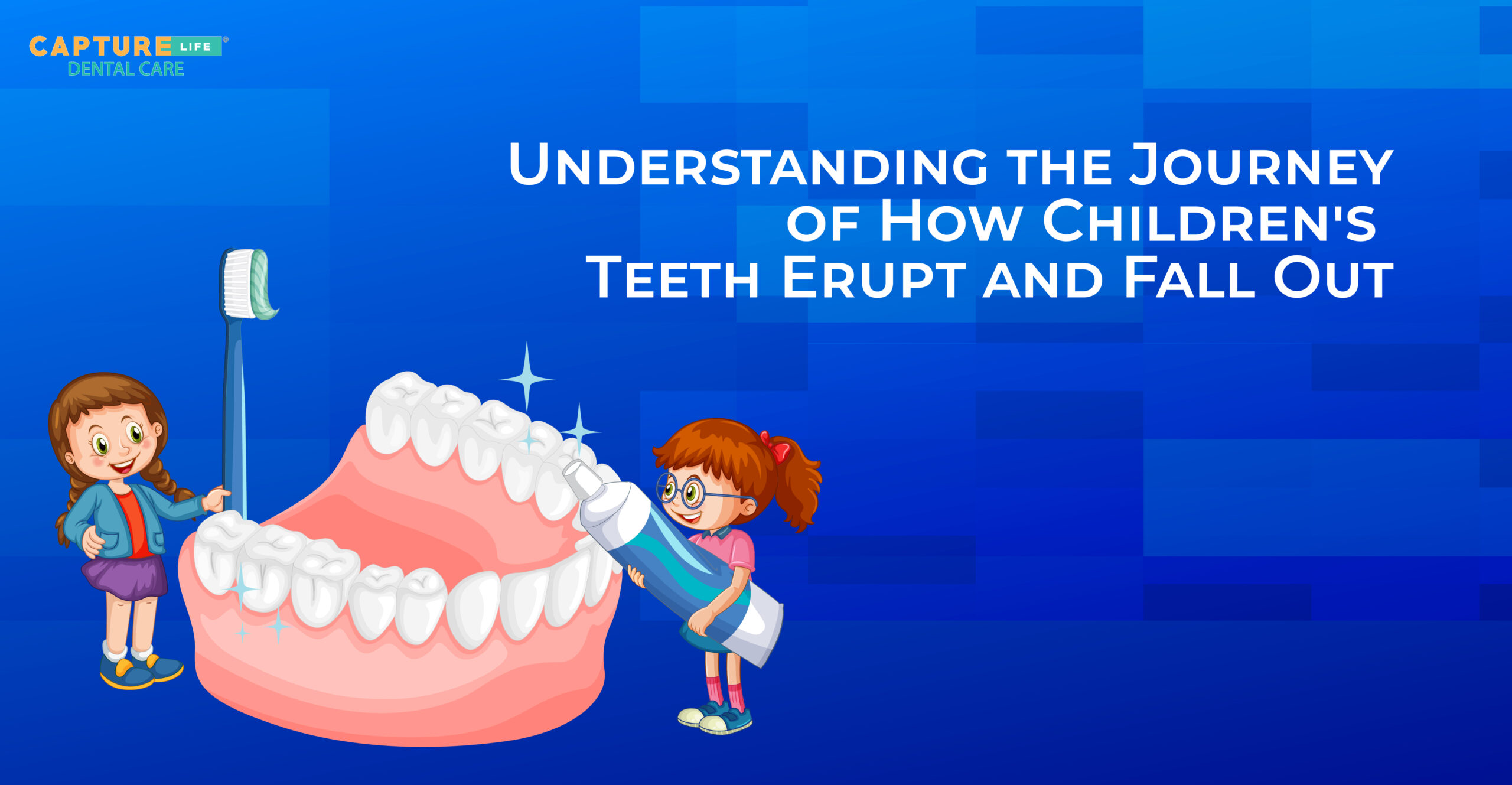
16 Nov The Journey of Children’s Teeth: Eruption, Growth, and Healthy Development
Introduction
Children’s teeth, those tiny pearls that bring joy to parents and a smile to their little ones, go through an incredible journey as they make their appearance. Have you ever wondered how these teeth manage to erupt through the gums and eventually fall out? Understanding this process is not only fascinating but also crucial for ensuring your child’s oral health.
Tooth Eruption Process
Understanding the stages of tooth eruption in children is essential for parents and caregivers, as it helps track a child’s dental development and identify any potential issues. Here’s a more detailed look at the stages of tooth eruption:
- Formation of Tooth Buds: Tooth development begins long before birth. In fact, tooth buds for primary (baby) teeth start forming in the fetus as early as six weeks of gestation. These tooth buds contain the genetic instructions for the teeth, including their size, shape, and position.
- Eruption of Lower Central Incisors: The first teeth to make their appearance are usually the lower central incisors, also known as the bottom front teeth. This typically occurs between 6 to 10 months of age. These incisors are essential for biting and tearing food.
- Eruption of Upper Central Incisors: Following the lower central incisors, the upper central incisors (top front teeth) emerge. They usually appear between 8 to 12 months of age.
- Eruption of Lateral Incisors and First Molars: Around the age of 9 to 16 months, your child’s lateral incisors, which are located next to the central incisors, will erupt. Additionally, the first molars (back teeth) start to emerge during this stage.
- Canine Eruption: Canines, the pointed teeth between the incisors and first molars, typically erupt between 16 to 23 months of age. These teeth are crucial for tearing food and maintaining proper spacing in the mouth.
- Eruption of Second Molars: The second molars, located at the back of the mouth, typically appear between 23 to 31 months of age. These molars are important for chewing and grinding food.
- Shedding of Primary Teeth: As your child’s permanent teeth continue to develop, the roots of the primary (baby) teeth start to dissolve. This process allows the primary teeth to become loose and eventually fall out.
- Eruption of Permanent Teeth: Permanent teeth begin to emerge as primary teeth fall out. The first permanent teeth to appear are usually the lower central incisors, followed by the upper central incisors and so on, mirroring the eruption pattern of the primary teeth.
Why and How Teeth Push Through Gums
Tooth eruption is a fascinating biological process. It all starts with the formation of a tooth bud, which contains the developing tooth. This bud gradually pushes through the jawbone and into the gum tissue. As it moves upward, the tooth begins to mineralize, forming the hard enamel outer layer and the dentin beneath. This process continues until the tooth breaks through the gum tissue and becomes visible in the mouth.
The pressure exerted by the developing tooth is what causes the gum tissue to give way. It’s not uncommon for children to experience discomfort, known as teething, during this period. Providing them with safe teething toys or consulting your local dental clinic near you, such as Capture Life Dental Clinic, can help alleviate their discomfort.
Factors Affecting Tooth Eruption
Several factors can influence the timing and order of tooth eruption in children:
- Genetics: Tooth eruption patterns tend to run in families. If parents or grandparents experience early or delayed tooth eruption, it’s likely that their children will follow a similar pattern. While genetics play a role, it’s important to remember that each child is unique, and variations can occur.
- Nutrition: Proper nutrition is crucial for healthy tooth development. Calcium and vitamin D are essential nutrients for strong teeth and bones. Ensure that your child’s diet includes dairy products, leafy greens, fortified foods, and supplements if necessary. Consulting a pediatric dentist, like those at Capture Life Dental Clinic, can provide guidance on dietary choices.
- Overall Health: A child’s overall health can also impact tooth development. Certain medical conditions or medications may affect tooth eruption. Chronic illnesses or malnutrition can potentially delay tooth eruption and affect dental health.
- Oral Habits: Prolonged thumb-sucking, pacifier use, or other oral habits can affect the alignment of teeth and may influence the eruption pattern. Encouraging children to discontinue these habits at the appropriate age can help prevent dental issues.
- Injury or Trauma: Trauma to the mouth or jaw can disrupt the normal eruption process. If your child experiences a mouth injury, it’s essential to seek dental care promptly to assess and address any potential damage.
Supporting Healthy Tooth Development
Parents can actively support their child’s healthy tooth development. Establish good oral hygiene habits early on by gently cleaning your baby’s gums with a soft cloth. Once teeth emerge, switch to a soft-bristle toothbrush designed for infants and toddlers. Avoid sugary snacks and drinks, as they can contribute to tooth decay. By following the tips provided and seeking guidance from professionals like Capture Life Dental Clinic, you can help your child maintain a healthy and beautiful smile for years to come.
Regular dental check-ups are essential. Schedule your child’s first dental visit within six months of their first tooth appearing or by their first birthday. Capture Life Dental Clinic, one of the best dental clinics near you, specializes in pediatric dentistry and can provide guidance on oral care tailored to your child’s needs.

